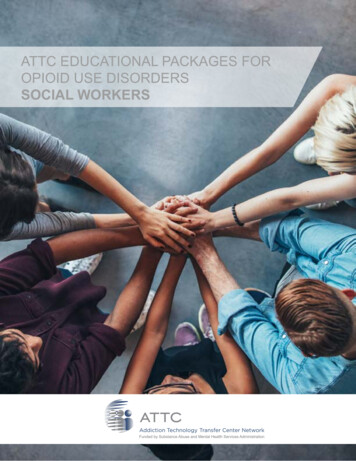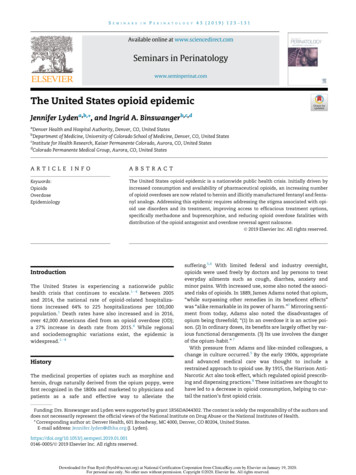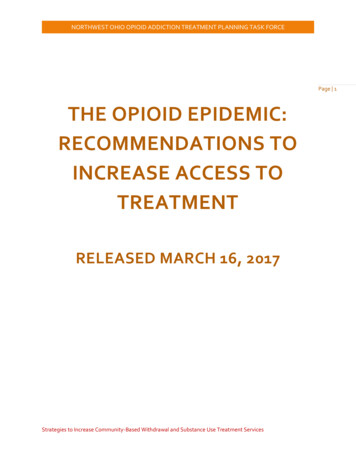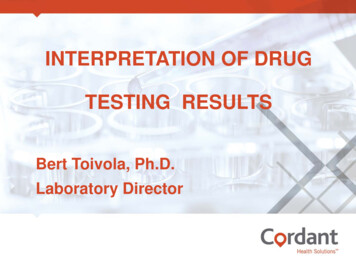
Transcription
ATTC EDUCATIONAL PACKAGES FOROPIOID USE DISORDERSSOCIAL WORKERS
DISCLAIMERThe Addiction Technology Transfer Center Network prepared this publication under a cooperative agreementfrom the Substance Abuse and Mental Health Services Administration’s (SAMHSA) Center for Substance AbuseTreatment (CSAT). All material appearing in the publication except that taken directly from copyrighted sources isin the public domain and may be reproduced or copied without permission from SAMHSA/CSAT or the authors.Citation of the sources is appreciated.At the time of this publication, Elinore F. McCance-Katz, M.D., Ph.D., served as the Assistant Secretary of MentalHealth and Substance Use. Captain Chideha Ohuoha, M.D., M.P.H., served as the CSAT Director, and HumbertoCarvalho, MPH, served as the CSAT Project Officer.The opinions expressed herein are the views of the authors and do not reflect the official position of theDepartment of Health and Human Services (DHHS), SAMHSA, or CSAT. No official support or endorsement ofDHHS, SAMHSA, or CSAT for the opinions described in this document is intended or should be inferred.This report has not been published elsewhere, nor has it been submitted simultaneously for publication elsewhere.The work reported in this manuscript was supported by SAMHSA cooperative agreement: TI080205-01.CONTRIBUTORSHumberto M. Carvalho, MPHPublic Health Advisor – Project OfficerOffice of Management, Analysis, andCoordination - OMACSubstance Abuse and Mental HealthServices Administration - SAMHSALaurie Krom, MSCo-DirectorATTC Network Coordinating OfficeHolly Hagle, PhDCo-DirectorATTC Network Coordinating OfficeMaureen FitzgeraldCommunications CoordinatorATTC Network Coordinating OfficeGreat Lakes ATTCLeAnna CatesResearch AssistantATTC Network Coordinating OfficeREVIEWERS:Angelo McClain, PhD, LICSWChief Executive OfficerNational Association of Social Workers (NASW)Sharon Dietsche, ACSW, DCSW, LICSW, LCSW-CSenior Practice Associate / IRB ChairNational Association of Social Workers (NASW)Heidi McIntosh, MSWDeputy Director of ProgramsNational Association of Social Workers (NASW)Darla Spence Coffey, PhD, MSWPresidentCouncil of Social Work Education (CSWE)
INTRODUCTIONThe Addiction Technology Transfer Center (ATTC) Network Coordinating Office (NCO), funded by theSubstance Abuse and Mental Health Services (SAMHSA), has designed three competency-based guidesto raise awareness of resources available to build the capacity of the workforce to address the opioid crisis.The digital guides are relevant to psychologists, counselors, social workers, peer support workers, and otherbehavioral health professionals who intersect with people at risk for misuse of, or who are already misusing,opioids. Contemporary use of prescription or illicit opioids has led to the current opioid crisis in the US, whereopioid overdose has increased fivefold since 1999 and where every day more than 115 people die of an opioidoverdose. It is important to acknowledge the continuum of prevention, treatment, and recovery when addressingpeople who have, or are at risk of developing, an opioid use disorder. Therefore, we have organized the guidesto align with this continuum.The methods used to develop the guides follow: Initial development and planning meeting between senior SAMHSA and ATTC NCO staff identified the needfor the document and target audiences. The need was identified through an increase in requests to SAMHSAto educate the behavioral health field on understanding and addressing opioid use. Senior staff at the ATTC NCO held several exploratory meetings to review materials that are currentlyavailable on the ATTC and SAMHSA websites. In addition, senior staff identified the core competencies foreach of the target audiences (psychologists and counselors, social workers, and peer support workers) touse for a crosswalk of competencies and resources. ATTC NCO senior staff conducted a crosswalk of competencies and resources through an iterative processof resource review and matching those resources to particular competencies. The identified competencies and resources were then sent out for review by subject matter experts (SMEs)from the Center for Social Innovation (C4), Council on Social Work Education (CSWE), InternationalCertification & Reciprocity Consortium (IC&RC), and NAADAC, the Association for AddictionProfessionals. ATTC NCO senior staff reviewed the SMEs’ recommendations and made recommended revisions. ATTC NCO senior staff conducted two rounds of review to come to consensus on the final arrangement ofthe crosswalk of the competencies and matching resources.It is the hope of the ATTC NCO that this digital guide will give the behavioral healthcare workforce informationto be able to enhance their professional knowledge and skills so that all can have an appropriate, active role inpreventing, treating, and/or supporting recovery from opioid use disorders.
QUICK GUIDEStep 1. Choose an Area of FocusStep 2. Click on a Resource IconThere are 15 competencies listed in this interactiveguide to assist Social Work providers in enhancingtheir professional knowledge, attitudes, and skillsin preventing, treating, and supporting recoveryof patients and communities with opioid usedisorders. Refer to the Table of Contents to identifythe competency that matches your learning orprofessional objectives.Resources listed below each competency wereselected to address the knowledge, skills, andattitudes required to meet such competency. Eachhas been vetted and recommended by senior staffat the ATTC Network Coordinating Office. Click onan icon to transfer you to the resource for furtherexploration.Resources are presented in a variety of formats toappeal to a larger audience with diverse learningstyles. View the resource format key below for furtherclarification.RESOURCE FORMAT KEYOnline ointsToolkitPDF DocumentsBibliographyFact SheetMobile AppsReportPeerReviewedArticleWebinarsMovieYouTube alEventsRequiring TravelWebsitesArticlesBlog PostsTIPTreatmentImprovementProtocol (TIP)CurriculumTAPTechnicalAssistancePublication (TAP)Chart
TABLE OF CONTENTSPREVENT OPIOID MISUSEUnderstand the role of prevention in addressing the opioid crisis . 6Understand naloxone distribution and use as an opioid antagonist . 7Apply types of prevention strategies across levels of intervention, including the individual, family,school, agency community, or larger context. 8INTERVENE WITH INDIVIDUALS AT RISK FOR OPIOID USE DISORDERSRecognize the risk factors for, and signs of, opioid overdose . 10Understand the epidemiology of opioid use and problems with opioid use, as well as the predictorsof opioid use and abuse in populations, across place and development.11Demonstrate an awareness of how to inform individual . 14PROVIDE SAFE, INFORMED, PERSON-CENTERED CARE FOR PEOPLE WITHOPIOID USE DISORDERSRecognize substance and opioid use disorders as a chronic disease . 15Demonstrate an understanding of the substance use disorder treatment and recovery supportssystem, and how to appropriately refer individuals. 16Assess for trauma, co-occurring disorders, suicide risk, and physical health in planning recovery activitiesand treatment. 19Ensure that all clients and their families are provided with services within a context of culturalunderstanding and competence . 21Articulate the foundational skills in person-centered counseling and behavior change . 23Be able to recognize and assess their own and societal stigmas and biases and be knowledgeable aboutvarious perspectives on social constructions of opioid use, misuse, abuse, and dependence . 24UNDERSTAND YOUR ROLEEngage in advocacy that seeks to ensure that clients with substance use disorders and their familieshave equal access to the appropriate services in a timely manner. . 25Advocate at multiple levels for health promotion and for reduction of health disparities and stigma fordiverse populations affected by opioids and opioid use disorders. 26Engage in self-care methods and seek support to develop awareness, insight, and resiliency to moreeffectively manage the effects of trauma and retraumatization in their lives . 27
COMPETENCY:UNDERSTAND THE ROLE OF PREVENTION INADDRESSING THE OPIOID CRISISPREVENT OPIOID MISUSESource: The President’s Commission on Combating Drug Addiction and the Opioid CrisisAddressing the Opioid Crisis:Prioritizing What Works(2018)SAMHSA’s Center for theApplication of PreventionTechnologiesThe Role of Prevention inAddressing Opioid Overdose(2016)SAMHSA’s Center for theApplication of PreventionTechnologiesOpioid Overdose and theRole of Prescriber Education(2018)SAMHSA’s Center for theApplication of PreventionTechnologiesPreventing Drug Use AmongChildren and Adolescents(2003)National Institute on DrugAbuseSeeing the Whole Elephant:The Critical Role ofCollaboration in Addressingthe Opioid Crisis (2018)SAMHSACollaboration to PreventOpioid Misuse and Overdose:Eliminating Silos (2018)SAMHSAFacing Addiction in America:The Surgeon General’sReport on Alcohol, Drugs,and Health (2016)The Surgeon General’sOfficeGiven the impact ofsubstance misuse on publichealth and the increasedrisk for long-term medicalconsequences, includingsubstance use disorders,it is critical to preventsubstance misuse fromstarting and to identify thosewho have alreadybegun to misuse substancesand intervene early.Facing Addiction in America: The SurgeonGeneral’s Report on Alcohol, Drugs, andHealth.6SOCIAL WORKERS
COMPETENCY:UNDERSTAND NALOXONE DISTRIBUTION ANDUSE AS AN OPIOID ANTAGONISTSource: Surgeon General’s Advisory on Naloxone and Opioid OverdoseAddressing the Opioid Crisis:How Naloxone Is Changingthe Way We Think AboutPrevention (2018)SAMHSAMedication and CounselingTreatment – Naloxone (2018)SAMHSAPreventing Opioid Overdose:Increasing the Availability ofNaloxone (2018)SAMHSA’s Center for theApplication of PreventionTechnologiesHarm Reduction and OpioidMisuse: Looking BeyondNaloxone (2018)SAMHSA’s Center for theApplication of PreventionTechnologies“For patients currently taking highdoses of opioids as prescribedfor pain, individuals misusingprescription opioids, individualsusing illicit opioids such as heroinor fentanyl, healthcare practitioners,family and friends of people whohave an opioid use disorder, andcommunity members who come intocontact with people at risk for opioidoverdose, knowing how to usenaloxone and keeping it within reachcan save a life.”PREVENT OPIOID MISUSESAMHSA Opioid OverdosePrevention Toolkit (2018)SAMHSABE PREPARED.GET NALOXONE. SAVE A LIFE.Surgeon General’s Advisory on Naloxoneand Opioid Overdose Surgeon General of theUnited States Public Health Service, VADMJerome AdamsPreparing for NaloxoneDistribution: Resources forFirst Responders and Others(2018)SAMHSA Center for theApplication of PreventionTechnologiesGet Naloxone Now (2017)Get Naloxone NowSOCIAL WORKERS7
COMPETENCY:APPLY TYPES OF PREVENTION STRATEGIESACROSS LEVELS OF INTERVENTION,INCLUDING THE INDIVIDUAL, FAMILY, SCHOOL,AGENCY COMMUNITY, OR LARGER CONTEXTPREVENT OPIOID MISUSESource: Advanced Social Work Practice in Prevention of Substance Use DisordersThe Role of PreventionFollowing a Non-FatalOverdose (2018)SAMHSAEasier Together: PartneringWith Families to MakeRecovery Possible (2017)Mid-America ATTCThe Opioid Crisis: CommunityIs Key to Addressing theEpidemic (2018)ATTC/NIATx ServiceImprovementResponding to the OpioidEpidemic (2017)ATTC/NIATxRecovery CommunityOrganizations (2018)Faces and Voices of RecoveryDatabaseSAMHSA’s Center for theApplication of PreventionTechnologies (CAPT) is anational substance abuseprevention system committedto strengthening preventionefforts at the national, regional,state, and local levels, and tobuilding the nation’s substanceabuse prevention workforce.8SOCIAL WORKERS
Preventing Prescription DrugMisuse: Understanding Who Isat Risk (2016)SAMHSA’s Center for theApplication of PreventionTechnologiesPreventing Prescription DrugMisuse: Selected Strategiesand Associated Risks (2017)SAMHSA’s Center for theApplication of PreventionTechnologiesPreventing Prescription DrugMisuse: Overview of Factorsand Strategies (2016)SAMHSA’s Center for theApplication of PreventionTechnologiesSOCIAL WORKERS9PREVENT OPIOID MISUSEJune 2017: CommunityHealth Centers and FirstResponders: StrengtheningCommunities ThroughEducationSAMHSA Road to Recovery
INTERVENE WITH INDIVIDUALS AT RISK FOR OPIOID USE DISORDERSCOMPETENCY:RECOGNIZE THE RISK FACTORS FOR, ANDSIGNS OF, OPIOID OVERDOSESource: Massachusetts Social Work Education Core Principles for the Prevention andManagement of Substance MisuseUnderstanding andOvercoming Opioid Abuse(2018)American PsychologicalAssociationOpioid Overdose PreventionToolkit (2016)SAMHSASIGNS OF AN OPIOID OVERDOSERecognizing an opioid overdose can be difficult. Here are afew signs and symptoms to look out for: Unconsciousness or unresponsivenessShallow breathing or no breathingPinpoint pupilsIf you suspect someone is overdosing or in distress, it isimportant that you don’t leave the person alone and that youcall 911 and seek immediate medical care for the individual.CDC Prevent Prescription Opioid Overdose10SOCIAL WORKERS
UNDERSTAND THE EPIDEMIOLOGY OF OPIOIDUSE AND PROBLEMS WITH OPIOID USE, ASWELL AS THE PREDICTORS OF OPIOID USEAND ABUSE IN POPULATIONS, ACROSSPLACE AND DEVELOPMENTSource: Advanced Social Work Practice in Prevention of Substance Use Disorders andMassachusetts Social Work Education Core Principles for the Prevention and Management ofSubstance MisuseAn Update on the OpioidCrisis (2018)SAMHSA/HHSHHS U.S. Opioid Epidemic(2018)US Department of Health andHuman ServicesBig Data and the OpioidEpidemic (2018)amfARAHRQ Data Show Impact ofOpioid Crisis at County Level:New Insights iInto CommunityHospitalization Rates forSubstance Use (2018)Agency for HealthcareResearch and QualityCDC Vital Statistics RapidRelease: Provisional DrugOverdose Death Counts(2018)Centers for Disease Control andPreventionSAMHSA/HHS: An Update onthe Opioid Crisis (2018)SAMHSA/HHSSOCIAL WORKERS11INTERVENE WITH INDIVIDUALS AT-RISK FOR OPIOID USE DISORDERSCOMPETENCY:
INTERVENE WITH INDIVIDUALS AT RISK FOR OPIOID USE DISORDERSCOMPETENCY:UNDERSTAND THE EPIDEMIOLOGY OFOPIOID USE AND PROBLEMS WITH OPIOIDUSE, AS WELL AS THE PREDICTORS OFOPIOID USE AND ABUSE IN POPULATIONS,ACROSS PLACE AND DEVELOPMENTSource: Advanced Social Work Practice in Prevention of Substance Use Disorders and MassachusettsSocial Work Education Core Principles for the Prevention and Management of Substance MisuseUsing Prescription DrugMonitoring Program Data toSupport Prevention Planning(2017)SAMHSA’s Center for theApplication of PreventionTechnologiesPreventing Opioid Misuse andOverdose: Data Sources andTools to Inform Assessmentand Planning Efforts (2017)SAMHSA’s Center for theApplication of PreventionTechnologiesPreventing Opioid Misuseand Overdose: Using Data toCorrect Misperceptions (2017)SAMHSA’s Center for theApplication of PreventionTechnologies12SOCIAL WORKERSFacing Addiction in America:The Surgeon General’sReport on Alcohol, Drugs,and Health (2016)U.S. Department of Health &Human Services; SAMHSA2016 NSDUH ReportAmerica’s Behavioral HealthChanges & ChallengesSAMHSA National Survey onDrug Use and Health
INTERVENE WITH INDIVIDUALS AT RISK FOR OPIOID USE DISORDERSTHE OPIOID EPIDEMIC BY THE NUMBERSIN 2016.116People died every dayfrom opioid-relateddrug overdoses42,24911.5 mPeople misusedprescription opioids12.1 millionPeople died fromoverdosing on opioids2People misused prescriptionopioids for the first time12.1 million17,087948,00019,413Deaths attributed tooverdosing on commonlyprescribed opioids2People had an opioid usedisorder1Deaths attributed to overdosingon synthetic opioids other thanmethadone2People used heroin115,469170,000Deaths attributed tooverdosing on heroin2People used heroin forthe first time1504 billionIn economic costs3Sources: 1 2016 National Survey on Drug Use and Health, 2 Mortality in the United States, 2016 NCHS Data Brief No. 293, December 2017, 3 CEA Report: Theunderestimated cost of the opioid crisis, 2017Updated January 2018. For more information, visit: http://www.hhs.gov/opioids/SOCIAL WORKERS13
INTERVENE WITH INDIVIDUALS AT RISK FOR OPIOID USE DISORDERSCOMPETENCY:DEMONSTRATE AN AWARENESS OF HOWTO INFORM INDIVIDUALSource: Massachusetts Social Work Education Core Principles for the Preventionand Management of Substance MisuseTalking About Overdose WithPeople Who Use Opioids(2018)SAMHSA’S Center for theApplication of PreventionTechnologiesHealtheKnowledge (2016) SBIRT for Health andBehavioral HealthProfessionals Foundations of SBIRTATTC NetworkTreatment Referral in anOpioid Crisis: Opportunitiesto Engage (2016)Institute for Research,Education & Training inAddictions Intervention25%or more25% or more of patients about their alcohol or druguse with a professionaltrained in Screening BriefIntervention and Referralto Treatment for SubstanceUse.The UMKC SBIRT Project14SOCIAL WORKERS
RECOGNIZE SUBSTANCE AND OPIOID USEDISORDERS AS A CHRONIC DISEASESource: Massachusetts Social Work Education Core Principles for the Prevention andManagement of Substance MisuseAddiction as a Disease —Not a Moral Failure (2018)SAMHSAAddiction Is a ChronicDisease (2018)NIDAAddressing Addiction as aChronic Disease: What doesScience Tell Us? (2016)ATTC NetworkTreating Opioid Addiction asa Chronic Disease (2014)ASAMOPIOID ADDICTION IS A CHRONIC BRAIN DISEASEAddiction is a primary, chronic disease of brain reward, motivation,memory, and related circuitry. Dysfunction in these circuits leadsto characteristic biological, psychological, social, and spiritualmanifestations.American Society of Addiction Medicine Fact Sheet:Treating Opioid Addiction as a Chronic DiseaseSOCIAL WORKERS15PROVIDE SAFE, INFORMED, PERSON-CENTERED CARE FOR PEOPLE WITH OPIOID USE DISORDERSCOMPETENCY:
PROVIDE SAFE, INFORMED, PERSON-CENTERED CARE FOR PEOPLE WITH OPIOID USE DISORDERSCOMPETENCY:DEMONSTRATE AN UNDERSTANDING OF THESUBSTANCE USE DISORDER TREATMENT ANDRECOVERY SUPPORTS SYSTEM, AND HOW TOAPPROPRIATELY REFER INDIVIDUALSSource(s): Advanced Social Work Practice in Prevention of Substance Use Disorders andNASW Standards for Social Work Practice for Clients with Substance Use Disorders andMassachusetts Social Work Education Core Principles for the Prevention andManagement of Substance MisuseSBIRT: Screening, BriefIntervention, and Referral toTreatment (2018)SAMHSA-HRSA Center forIntegrated Health SolutionsThe Basics of AddictionCounseling Desk Reference,11th Edition (2018) Module 1: Pharmacologyof PsychoactiveSubstance Use Disorders Module II: AddictionCounseling Theories,Practices, and Skills Module III: Ethical andProfessional Issues inAddiction CounselingNAADACASAM Criteria Resources andTraining (2018)American Society of AddictionMedicineTIP16SAMHSA TIP 63: Medicationsfor Opioid Use Disorder (2018)SAMHSA (TIP)SOCIAL WORKERSPCSS MAT Training (2018) Myths andMisconceptions ofMedication-AssistedTreatment Considerations inMedication-AssistedTreatment of OpiateDependence Improving OpioidPrescribing: The CDCGuideline for PrescribingOpioids for Chronic Pain Opioid Dependence 101and MAT 2002 to 2017:The Evolution ofBuprenorphine Treatment Follow Up Q&A Webinar:The ASAM NationalPractice Guideline for theUse of Medications in theTreatment of AddictionInvolving Opioid UseProviders Clinical SupportSystemCultivating Change Talk, Part2 (2018)Institute for Research,Education & Training inAddictions
August 2017: Responding tothe Opioid EpidemicATTC/NIATx and Treatment of OUD:Current best practices management of opioid usedisorder (2017)Harvard Medical School GlobalAcademyRecovery LIVE! Opioid UseDisorder, Medication, andRecovery (2017)SAMHSAHealtheKnowledge (2016): SBIRT for Health andBehavioral HealthProfessionals Foundations of SBIRTATTC NetworkTreatment Referral in anOpioid Crisis: Opportunitiesto Engage (2016)Institute for Research,Education & Training inAddictions“The primary goals and general management methods of treatmentfor substance use disorders are the same as those for thetreatment of other chronic illnesses. The goals of treatment areto reduce key symptoms to non-problematic levels and improvehealth and functional status; this is equally true for those with cooccurring substance use disorders and other psychiatric disorders.Key components of care are medications, behavioral therapies,and recovery support services (RSS).”Facing Addiction in America: The Surgeon General’sReport on Alcohol, Drugs, and HealthSOCIAL WORKERS17PROVIDE SAFE, INFORMED, PERSON-CENTERED CARE FOR PEOPLE WITH OPIOID USE DISORDERSMI Skill Building: How toRecognize, Respond to, andElicit Change Talk, Part 1(2017)Institute for Research,Education & Training inAddictions
PROVIDE SAFE, INFORMED, PERSON-CENTERED CARE FOR PEOPLE WITH OPIOID USE DISORDERSCOMPETENCY:DEMONSTRATE AN UNDERSTANDING OF THESUBSTANCE USE DISORDER TREATMENT ANDRECOVERY SUPPORTS SYSTEM, AND HOW TOAPPROPRIATELY REFER INDIVIDUALSSource(s): Advanced Social Work Practice in Prevention of Substance Use Disorders andNASW Standards for Social Work Practice for Clients with Substance Use Disorders andMassachusetts Social Work Education Core Principles for the Prevention andManagement of Substance MisusePlan Your Recovery PersonalStories (2016)Plan Your RecoveryScreening and BriefIntervention Guidance (2014) Identifying Patients withSubstance Use Disorders Screening for SubstanceUse Disorders Tips for ConductingBrief Intervention andAssessing Readiness toChange The Clinical Assessmentof Substance UseDisorders Case Study Substance Use Disordersin Adolescents:Screening andEngagement in PrimaryCare SettingsNational Institute on DrugAbuseIn My Own Words: ACompilation of Essaysby Individuals Supportedby Medication-AssistedTreatment in Long-TermRecovery (2011)ATTC Network18SOCIAL WORKERSTRACKING PATIENTS’RESPONSE TO TREATMENT“A further indicator of qualitytreatment is having reliable, validmeasurement systems in place totrack patients’ response to treatment.Similar to regular assessment of bloodpressure ateach checkup in uld collect“addictionand mentalhealth vitalsigns” in orderto monitor the effectiveness orineffectiveness of the individualizedtreatment plan and adjust itaccordingly when needed. Withoutany kind of standardized metrics, it is patients’ progress.”Recovery Research InstituteGuide to Effective AddictionTreatment: 11 Indicators of Quality
ASSESS FOR TRAUMA, CO-OCCURRINGDISORDERS, SUICIDE RISK, AND PHYSICALHEALTH IN PLANNING RECOVERY ACTIVITIESAND TREATMENTSource: Advanced Social Work Practice in Mental Health RecoveryThe Intersection of OpioidAbuse, Overdose, andSuicide: Understanding theConnections (2018)SAMHSA’s Center for theApplication of PreventionTechnologiesHeroin, Prescription Opioids,and HIV: What CliniciansNeed to Know (2018)Pacific Southwest ATTCDecisions in Recovery:Planning for Success (2016)SAMHSA BRSS TACSDecisions in Recovery:Treatment for Opioid UseDisorders (2016)SAMHSASOCIAL WORKERS19PROVIDE SAFE, INFORMED, PERSON-CENTERED CARE FOR PEOPLE WITH OPIOID USE DISORDERSCOMPETENCY:
PROVIDE SAFE, INFORMED, PERSON-CENTERED CARE FOR PEOPLE WITH OPIOID USE DISORDERSCOMPETENCY:ASSESS FOR TRAUMA, CO-OCCURRINGDISORDERS, SUICIDE RISK, AND PHYSICALHEALTH IN PLANNING RECOVERY ACTIVITIESAND TREATMENTSource: Advanced Social Work Practice in Mental Health RecoveryCo-Occurring Disorders(2016)SAMHSATIPTIPTIP 57: Trauma Informed Carein Behavioral Health Services(2014)SAMHSATIP 42: Substance AbuseTreatment for Persons WithCo-Occurring Disorders(2013)SAMHSAIntegrating Treatment forCo-Occurring Disorders: AnIntroduction to What EveryAddiction Counselor Needs toKnow (2011)NADAAC20SOCIAL WORKERSTrauma-specific interventionprograms generally recognize thefollowing: The survivor’s need to berespected, informed, connected,and hopeful regarding their ownrecovery The interrelation between traumaand symptoms of trauma suchas substance abuse, eatingdisorders, depression, andanxiety The need to work in acollaborative way with survivors,family and friends of the survivor,and other human-servicesagencies in a manner thatwill empower survivors andconsumersSAMHSA, Trauma-Informed Approachand Trauma-Specific Interventions
ENSURE THAT ALL CLIENTS AND THEIRFAMILIES ARE PROVIDED WITH SERVICESWITHIN A CONTEXT OF CULTURALUNDERSTANDING AND COMPETENCESource(s): NASW Standards for Social Work Practice for Clients with Substance Use DisordersTalking About Overdose WithPeople Who Use Opioids(2018)SAMHSA’S Center for theApplication of PreventionTechnologiesHealtheKnowledge (2018): Understanding the Basisof Race, Ethnicity, andCultureATTC NetworkNew England ATTCOpioid Misuse in RuralAmerica (2018)USDAHealth Disparities WithinLatino and African AmericanCommunities (2018)SAMHSAATTC Center of Excellence:YMSM LGBT Resources(2018)ATTC NetworkCultural Competency andSpirituality (2017)Mid-America ATTC; FamilyCentered Behavioral HealthSupport for Pregnant andPostpartum WomenADVANCING HEALTH EQUITY AT EVERY POINT OF CONTACTThe National Standards for Culturally andLinguistically Appropriate Services in Health andHealth Care (The National CLAS Standards) aimto improve health care quality and advance healthequity by establishing a framework for organizationsto serve the nation’s increasingly SOCIAL WORKERS21PROVIDE SAFE, INFORMED, PERSON-CENTERED CARE FOR PEOPLE WITH OPIOID USE DISORDERSCOMPETENCY:
PROVIDE SAFE, INFORMED, PERSON-CENTERED CARE FOR PEOPLE WITH OPIOID USE DISORDERSCOMPETENCY:ENSURE THAT ALL CLIENTS AND THEIRFAMILIES ARE PROVIDED WITH SERVICESWITHIN A CONTEXT OF CULTURALUNDERSTANDING AND COMPETENCESource(s): NASW Standards for Social Work Practice for Clients with Substance Use DisordersCultural Competence andOrganizational Change (2016)ATTC NIATxEngaging DiversePopulations in RecoverySupport Services (2016)SAMHSATIPTIP 59: Improving CulturalCompetence (2015)SAMHSARisk and Protective Factorsfor Substance Abuse and/or Mental Health ProblemsAmong Alaska Native andNative American Populations(2013)SAMHSA Center forApplication of PreventionTechnologiesCultural Elements inTreating Hispanic and LatinoPopulations (2013)ATTC NetworkThrough the DiamondThreshold: PromotingCultural Competency inUnderstanding AmericanIndian Substance Misuse(2011)ATTC NetworkNearly Every Age Group Has Been Touched by the Opioid Epidemic:22SOCIAL WORKERS
ARTICULATE THE FOUNDATIONAL SKILLSIN PERSON-CENTERED COUNSELING ANDBEHAVIOR CHANGESources: Massachusetts Social Work Education Core Principles for the Prevention andManagement of Substance MisuseThe Basics of AddictionCounseling Desk Reference,11th Edition (2018) Module 1: Pharmacologyof PsychoactiveSubstance Use Disorders Module II: AddictionCounseling Theories,Practices, and Skills Module III: Ethical andProfessional Issues inAddiction CounselingNAADACPatient-Centered OpioidAddiction Treatment (P-COAT)(2018)ASAMCreating Recovery-Oriented,Person-Centered Plans WithCommunity Resources (2016)SAMHSAPatient-Centered Care inOpioid Treatment Programs(2018)ATTC NorthwestWhat IsPerson-CenteredCare?Person-centered care—also knownas patient-centered care—meansconsumers have control over theirservices, including the amount,duration, and scope of services, as wellas choice of providers.SAMHSA, Person- and Family-CenteredCare and Peer SupportSOCIAL WORKERS23PROVIDE SAFE, INFORMED, PERSON-CENTERED CARE FOR PEOPLE WITH OPIOID USE DISORDERSCOMPETENCY:
PROVIDE SAFE, INFORMED, PERSON-CENTEREDCAREFOR ROLEPEOPLE WITH OPIOID USE DISORDERSUNDERSTANDYOURCOMPETENCY:BE ABLE TO RECOGNIZE AND ASSESS THEIROWN AND SOCIETAL STIGMAS AND BIASESAND BE KNOWLEDGEABLE ABOUT VARIOUSPERSPECTIVES ON SOCIAL CONSTRUCTIONSOF OPIOID USE, MISUSE, ABUSE, ANDDEPENDENCESource: 1) Massachusetts Social Work Education Core Principles for the Prevention andManagement of Substance Misuse 2) Advanced Social Work Practice in Prevention of SubstanceUse Disorders24Examining Our Biases AboutPeople Who Misuse Opioids(2018)SAMHSA’s Center for theApplication of PreventionTechnologiesLanguage Matters: Using Inspire Hope and AdvanceRecovery (2017)Mid-America ATTCReframing the OpioidPrevention Narrative:Addressing Misperceptions(2018)SAMHSACultural Activation Prompts(2016): Gaining Awareness, Part I Materials Gaining Awareness, PartIISAMHSASOCIAL WORKERS
Source: NASW Standards for Social Work Practice for Clients with Substance UseDisordersCoalition to Stop OpioidOverdose (2018)ASAMSAMHSA Opioid OverdosePrevention Toolkit (2018)SAMHSAOpioids Advocacy Toolkit(2018)ASAMOperation Naloxone:Bringing Opioid Awarenessand Prevention to CollegeCampuses (2017)NAADACADVOCACY IN ACTION“O
In addition, senior staff identified the core competencies for each of the target audiences (psychologists and counselors, social workers, and peer support workers) to use for a crosswalk of competencies and resources. ATTC NCO senior staff conducted a crosswalk of competencies and resources through an iterative process










